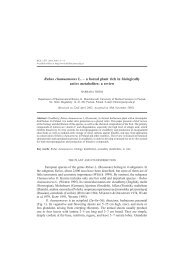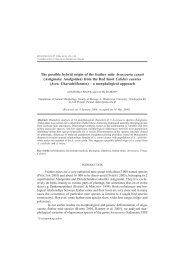Efficacy of new-generation acaricides in controlling mites in apple ...
Efficacy of new-generation acaricides in controlling mites in apple ...
Efficacy of new-generation acaricides in controlling mites in apple ...
You also want an ePaper? Increase the reach of your titles
YUMPU automatically turns print PDFs into web optimized ePapers that Google loves.
BIOLOGICAL LETT. 2006, 43(2): 347–351<br />
Available onl<strong>in</strong>e at http://www.biollett.amu.edu.pl<br />
EFFICACY OF NEW-GENERATION ACARICIDES<br />
<strong>Efficacy</strong> <strong>of</strong> <strong>new</strong>-<strong>generation</strong> <strong>acaricides</strong> <strong>in</strong> controll<strong>in</strong>g <strong>mites</strong><br />
<strong>in</strong> <strong>apple</strong> and plum orchards<br />
ALICJA MACIESIAK and REMIGIUSZ W. OLSZAK<br />
Research Institute <strong>of</strong> Pomology and Floriculture, Pomologiczna 18,<br />
96-100 Skierniewice, Poland; e-mail: mtart@<strong>in</strong>sad.pl<br />
(Received on 13 January 2006, Accepted on 6 November 2006)<br />
347<br />
Abstract: The effectiveness <strong>of</strong> <strong>acaricides</strong>: Envidor 240 SC (spirodicl<strong>of</strong>en) and Milbeknock EC<br />
(mibemect<strong>in</strong>) <strong>in</strong> controll<strong>in</strong>g <strong>mites</strong> <strong>in</strong> commercial <strong>apple</strong> and plum orchards was evaluated <strong>in</strong> 2001–2004<br />
<strong>in</strong> various localities. In all experiments, Milbeknock EC and Envidor 240 SC showed very high and longlast<strong>in</strong>g<br />
efficacy <strong>in</strong> controll<strong>in</strong>g <strong>mites</strong> on <strong>apple</strong> and plum trees. Dur<strong>in</strong>g 6–12 weeks follow<strong>in</strong>g the treatment,<br />
the mite population did not exceed the economical threshold level.<br />
Key words: <strong>mites</strong>, <strong>acaricides</strong>, Milbeknock EC, Envidor 240 SC<br />
INTRODUCTION<br />
Mites <strong>in</strong> orchards have been dangerous for a long time. Through suck<strong>in</strong>g out<br />
sap from leaves, spider <strong>mites</strong> reduce the level <strong>of</strong> photosynthesis and disturb transpiration.<br />
The <strong>in</strong>fested trees lose their leaves earlier than normally, the fruits are small<br />
and acid, and the crop yield is reduced. Markedly affected trees also reduce the number<br />
<strong>of</strong> flower buds set for the next year and are more susceptible to frost (GOLIK 1975).<br />
Chemical control should be applied very <strong>of</strong>ten, when mite density is at or above the<br />
economic threshold level. <strong>Efficacy</strong> <strong>of</strong> various preparations for control <strong>of</strong> the <strong>mites</strong><br />
have been <strong>in</strong>vestigated by many authors (SMOLARZ 1990, SMOLARZ et al. 1990,<br />
MACIESIAK & OLSZAK 2001). Adjustment to the rules obligatory <strong>in</strong> the European<br />
Union has resulted <strong>in</strong> withdrawal <strong>of</strong> some active compounds from pest control <strong>in</strong><br />
Poland (CZAPLICKI 2003). The products conta<strong>in</strong><strong>in</strong>g amitraz (Mitac 200 EC, Samba<br />
200 EC, Acaritox 200 EC) were elim<strong>in</strong>ated from the Polish register <strong>of</strong> <strong>acaricides</strong> <strong>in</strong><br />
2005. Other compounds can also be rejected until 2008. Test<strong>in</strong>g <strong>of</strong> <strong>new</strong>, modern<br />
<strong>acaricides</strong> is thus needed. This study aimed to evaluate some <strong>new</strong>-<strong>generation</strong> <strong>acaricides</strong><br />
(Envidor 240 SC and Milbeknock EC) for control <strong>of</strong> <strong>mites</strong> on <strong>apple</strong> and plum<br />
trees. The efficacy <strong>of</strong> these compounds has not been tested so far <strong>in</strong> commercial<br />
orchards <strong>in</strong> Poland. However, the product Envidor 240 EC has proved useful for<br />
control <strong>of</strong> two-spotted spider <strong>mites</strong> on currants (£ABANOWSKA 2002).
348 Alicja Maciesiak and Ryszard W. Olszak<br />
MATERIAL AND METHODS<br />
The experiments were conducted <strong>in</strong> 2001–2004 <strong>in</strong> several commercial orchards<br />
<strong>in</strong> some regions <strong>of</strong> Poland. The effectiveness <strong>of</strong> the <strong>new</strong> <strong>acaricides</strong> Envidor 240 SC<br />
(spirodicl<strong>of</strong>en) and Milbeknock EC (mibemect<strong>in</strong>) was compared with the standard<br />
preparations Mitac 200 EC (amitraz), Omite 30 WP (propargite), Ortus 05 SC (fenpyroximate).<br />
The experiments, conducted <strong>in</strong> 4 replicates, were set up <strong>in</strong> a block design<br />
with plots <strong>of</strong> 0.1–0.3 ha each as a comb<strong>in</strong>ation. Treatments were performed with a<br />
tractor sprayer us<strong>in</strong>g 600–750 l <strong>of</strong> spray<strong>in</strong>g liquid per ha. Mobile forms <strong>of</strong> spider<br />
<strong>mites</strong> were counted on leaves sampled from the external part <strong>of</strong> the crown <strong>of</strong> trees<br />
grow<strong>in</strong>g <strong>in</strong> the middle part <strong>of</strong> the plot. Population density was evaluated with HEN-<br />
DERSON & MCBURNIE’s (1943) method on 50 leaves for each replicate and date. A<br />
n=<br />
k−1<br />
t n<br />
cumulative <strong>in</strong>dex <strong>of</strong> <strong>in</strong>festation (CII = ∑ ( ⋅(<br />
x ))<br />
= 1<br />
n + x<br />
n<br />
n+<br />
1 mite unit days where k<br />
2<br />
is the number <strong>of</strong> occasions on which the <strong>mites</strong> were counted; n , n+<br />
1 are consecutive<br />
<strong>in</strong>dices; is the time, <strong>in</strong> days, between the consecutive <strong>in</strong>dices )<br />
(WRATTEN et al. 1979) was calculated for each test. The results were subjected to an<br />
analysis <strong>of</strong> variance. Duncan’s t test was employed to evaluate the significance <strong>of</strong><br />
differences at P=0.05.<br />
x x<br />
t n<br />
n , n+<br />
1 x x<br />
2<br />
Table 1. Effectiveness <strong>of</strong> Envidor 240 SC and Milbeknock EC <strong>in</strong> controll<strong>in</strong>g <strong>mites</strong> on <strong>apple</strong> trees (2001–<br />
2002)<br />
Treatment<br />
Rate/ha<br />
Mean no. <strong>of</strong> <strong>mites</strong> per leaf<br />
Weeks after treatment<br />
3–4 5–6 7–8 11–12<br />
Location A – Grzymkowice, near Grójec, spray<strong>in</strong>g date 17 May 2001<br />
Envidor 240 SC - 0.4 l 0.0 a* 0.0 a 0.0 a 0.1 a 0.5 a<br />
Milbeknock EC - 1.0 l 0.0 a 0.0 a 0.1 a 0.0 a 1.7 ab<br />
Omite 30 WP - 2.25 kg 0.3 b 0.02 a 0.05 a 0.5 a 5.1 b<br />
Control 1.9 c 4.7 b 3.1 b 3.3 b 100.0 c<br />
Location B – Wilcze Piêtki, near Grójec, spray<strong>in</strong>g date 25 May 2001<br />
Envidor 240 SC - 0.4 l 0.0 a 0.0 a 0.0 a 0.1 a 0.6 a<br />
Milbeknock EC - 1.0 l 0.01 a 0.0 a 0.0 a 0.1 a 1.0 a<br />
Omite 30 WP - 2.25 kg 0.5 b 0.0 a 0.8 ab 1.3 b 26.6 b<br />
Control 0.4 b 1.1 b 3.0 c 3.6 c 100.0 c<br />
Location C – Muchnice, near Kutno, spray<strong>in</strong>g date 10 May 2002<br />
Milbeknock EC - 0.75 l 0.6 b 0.4 b 0.3 a – 4.5 a<br />
Milbeknock EC - 1.0 l 0.1 a 0.02 a 0.1 a – 1.2 a<br />
Ortus 05 SC - 1.5 0.1 a 0.7 b 2.4 b – 8.6 a<br />
Control 18.8 c 10.8 c 12.1 c – 100.0 b<br />
Location D – Nowa Wieœ, near Grójec, spray<strong>in</strong>g date 9 May 2002<br />
Milbeknock EC - 0.75 l 0.03 a 0.0 a 0.02 a – 0.8 a<br />
Milbeknock EC - 1.0 l 0.05 a 0.0 a 0.0 a – 0.5 a<br />
Ortus 05 SC - 1.5 l 0.0 a 0.0 a 0.0 a – 0.0 a<br />
Control 8.7 b 1.7 b 3.8 b – 100.0 b<br />
CII – cumulative <strong>in</strong>dex <strong>of</strong> <strong>in</strong>festation (control = 100%)<br />
* Means followed by the same letter with<strong>in</strong> columns do not differ significantly at P=0.05<br />
CII<br />
(%)
Treatment<br />
Rate (kg/ha)<br />
EFFICACY OF NEW-GENERATION ACARICIDES<br />
RESULTS AND DISCUSSION<br />
Table 2. Effectiveness <strong>of</strong> Envidor 240 SC and Milbeknock EC <strong>in</strong> controll<strong>in</strong>g <strong>mites</strong> on <strong>apple</strong> trees (2003–<br />
2004)<br />
Mean no. <strong>of</strong> <strong>mites</strong> per leaf<br />
Weeks after treatment<br />
2 4 6 8<br />
Location E – Wilcze Piêtki, near Grójec, spray<strong>in</strong>g date 4 June 2003<br />
Milbeknock EC -0.75 l 0.0* 0.1 ab 0.1 ab 0.1 ab 3.2 ab<br />
Milbeknock EC - 1.0 l 0.0 a 0.05 a 0.0 a 0.02 a 2.6 a<br />
Ortus 05 SC - 1.0 l 0.0 a 0.1 ab 0.0 a 0.0 a 1.2 a<br />
Control 1.7 b 2.8 c 3.8 c 7.0 c 100.0 c<br />
Location F – Lewiczyn, near Grójec, spray<strong>in</strong>g date 27 April 2004<br />
Envidor 240 SC - 0.3 l 0.0 a 0.0 a 0.0 a 0.02 a 0.02 a<br />
Envidor 240 SC - 0.4 l 0.0 a 0.0 a 0.0 a 0.0 a 0.0 a<br />
Milbeknock EC - 0.75 l 0.0 a 0.02 a 0.0 a 1.3 b 0.8 a<br />
Milbeknock EC - 1.0 l 0.0 a 0.05 a 0.0 a 0.2 a 0.2 a<br />
Mitac 200 EC - 3.0 l 0.0 a 1.4 b 1.1 b 21.0 c 12.6 a<br />
Control 4.1 b 25.1 c 8.1 c 18.3 c 100.0 b<br />
Location G – Pêsy, near P³oñsk, spray<strong>in</strong>g date 28 April 2004<br />
Envidor 240 SC - 0.3 l 0.3 b 0.2 b 0.1 a 5.2 cd 13.3 b<br />
Envidor 240 SC - 0.4 l 0.1 ab 0.9 c 0.1 a 0.6 b 6.4 ab<br />
Milbeknock EC - 0.75 l 0.0 a 0.0 a 0.0 a 0.1 b 0.2 a<br />
Milbeknock EC - 1.0 l 0.0 a 0.0 a 0.0 a 0.0 a 0.0 a<br />
Mitac 200 EC - 3.0 l 0.0 a 0.02 a 0.02 a 0.0 a 0.3 a<br />
Control 5.7 b 7.9 c 5.9 b 18.2 d 100.0 b<br />
CII – cumulative <strong>in</strong>dex <strong>of</strong> <strong>in</strong>festation (control = 100%)<br />
* Means followed by the same letter with<strong>in</strong> columns do not differ significantly at P=0.05<br />
CII<br />
(%)<br />
349<br />
The <strong>acaricides</strong> Envidor 240 SC and Milbeknock EC <strong>in</strong> all experiments was very<br />
effective on <strong>apple</strong> (Tables 1, 2) and plum tress (Table 3). The mite population on<br />
<strong>apple</strong> leaves sprayed with this acaricide rema<strong>in</strong>ed below the economical threshold<br />
level (3 active stages <strong>of</strong> <strong>mites</strong> per leaf <strong>in</strong> the spr<strong>in</strong>g, and 5-7 <strong>mites</strong> per leaf <strong>in</strong> the<br />
summer) dur<strong>in</strong>g 8–12 weeks after treatment. A similar effect was obta<strong>in</strong>ed with the<br />
tested standard <strong>acaricides</strong>. At locations A and B (Table 1) on trees treated with Envidor<br />
240 SC and Milbeknock EC as well as with Omite 30 WP as the standard<br />
product, the density <strong>of</strong> spider <strong>mites</strong> was low dur<strong>in</strong>g the whole observation period<br />
(until 11–12 weeks after the treatment). At location D (Table 1) as well as at location<br />
E (Table 2), no spider <strong>mites</strong> were recorded dur<strong>in</strong>g 7-8 weeks after treatment with<br />
Milbeknock EC (0.75 l/ha and 1 l/ha) and the standard Ortus 05 SC. At location C<br />
an application <strong>of</strong> Milbeknock EC resulted <strong>in</strong> a very low density <strong>of</strong> the spider mite<br />
population dur<strong>in</strong>g the follow<strong>in</strong>g 7–8 weeks <strong>of</strong> observation, while the standard Ortus<br />
05 SC showed a somewhat shorter activity period (6 weeks). The products Envidor<br />
240 EC and Milbeknock EC applied at location F kept the density <strong>of</strong> spider <strong>mites</strong> at<br />
a low level dur<strong>in</strong>g 8 subsequent weeks <strong>of</strong> observation. The standard product Mitac<br />
200 EC showed a good activity dur<strong>in</strong>g 6 weeks after the treatment. However, 2 weeks<br />
later the densities <strong>of</strong> spider <strong>mites</strong> were high and comparable to the control. At location<br />
F the activity <strong>of</strong> Envidor 240 EC at a dose <strong>of</strong> 0.4 l/ha and Milbeknock EC on all
350 Alicja Maciesiak and Ryszard W. Olszak<br />
Table 3. Effectiveness <strong>of</strong> Envidor 240 SC and Milbeknock EC <strong>in</strong> controll<strong>in</strong>g <strong>mites</strong> on plum trees (2003–<br />
2004)<br />
Treatment Rate<br />
(kg/ha)<br />
Mean no. <strong>of</strong> <strong>mites</strong> per leaf<br />
Weeks after treatment<br />
2 5 7 9<br />
Location H – Ostrowiec, spray<strong>in</strong>g date 3 June 2003<br />
Envidor 240 SC 0.4 0.0 a* 0.0 a 0.0 a 0.1 a 0.5 a<br />
Milbeknock EC 0.75 0.0 a 0.02 a 0.0 a 0.02 a 0.2 a<br />
Milbeknock EC 1.0 0.0 a 0.02 a 0.0 a 0.0 a 0.2 a<br />
Mitac 200 EC 3.0 0.0 a 0.5 b 3.7 b 13.6 b 37.1 b<br />
Control – 0.6 b 4.1 c 14.5 c 21.7 b 100.0 c<br />
Location I – Mi³ob¹dz, spray<strong>in</strong>g date 16 July 2003<br />
Envidor 240 SC 0.4 0.3 a 0.7 a 0.05 a 0.1 a 1.8 a<br />
Milbeknock EC 0.75 4.3 b 2.8 a 2.8 b 1.4 b 14.2 b<br />
Milbeknock EC 1.0 2.4 a 1.6 a 0.3 a 0.3 a 5.7 a<br />
Mitac 200 EC 3.0 3.0 a 4.0 b 0.5 a 0.9 a 10.9 b<br />
Control – 25.6 c 20.9 c 17.4 c 18.8 c 100.0 c<br />
Location J – Ostrowiec, spray<strong>in</strong>g date 30 June 2004<br />
2 3 4 5 6<br />
Envidor 240 SC 0.4 0.03 a 0.0 a 0.8 a 1.3 a 0.1 a 8.9 a<br />
Milbeknock EC 0.75 0.02 a 0.0 a 1.1 ab 0.9 a 0.05 a 9.4 a<br />
Milbeknock EC 1.0 0.0 a 0.04 a 0.9 a 1.0 a 0.0 a 9.4 a<br />
Mitac 200 EC 3.0 0.05 a 3.7 b 2.4 bc 1.0 a 0.4 b 34.4 b<br />
Control – 15.4 b 8.3 c 3.1 c 4.0 b 4.7 c 100.0c<br />
CII – cumulative <strong>in</strong>dex <strong>of</strong> <strong>in</strong>festation (control = 100%)<br />
* Means followed by the same letter with<strong>in</strong> columns do not differ significantly at P=0.05<br />
dates <strong>of</strong> observation was similar to that <strong>of</strong> the standard Mitac 200 EC. In the same<br />
orchard, Envidor SC applied at a dose <strong>of</strong> 0.3 l/ha was effective for a shorter time.<br />
The products Envidor 240 EC as well as Milbeknock EC showed also a high efficacy<br />
<strong>in</strong> plum orchards (Table 3). Their application resulted <strong>in</strong> a very low density <strong>of</strong><br />
spider <strong>mites</strong> on all dates <strong>of</strong> observation, comparable with that obta<strong>in</strong>ed on trees treated<br />
with the standard Mitac 200 EC at locations H and J(2004). At location H(2003),<br />
however, the activity <strong>of</strong> Envidor 240 EC and Milbeknock EC was much better than<br />
that <strong>of</strong> the standard Mitac 200 EC. The products Envidor 240 SC and Milbeknock<br />
EC have demonstrated a high efficacy <strong>in</strong> controll<strong>in</strong>g spider <strong>mites</strong> <strong>in</strong> <strong>apple</strong> and plum<br />
orchards. They can thus replace the products conta<strong>in</strong><strong>in</strong>g amitraz, withdrawn from the<br />
market already, or the ones that can be withdrawn <strong>in</strong> the near future.<br />
CONCLUSIONS<br />
The high effectiveness <strong>of</strong> Envidor 240 SC (spirodicl<strong>of</strong>en) and Milbeknock EC<br />
(mibemect<strong>in</strong>) and their long-last<strong>in</strong>g action justifies their recommendation for practical<br />
use.<br />
CII<br />
(%)
EFFICACY OF NEW-GENERATION ACARICIDES<br />
REFERENCES<br />
351<br />
CZAPLICKI E. 2003. Re-exam<strong>in</strong>ation <strong>of</strong> “exist<strong>in</strong>g” active substances <strong>in</strong> European Union, procedure<br />
ECCO peer review meet<strong>in</strong>gs, expectations and requirements <strong>in</strong> Poland. Prog. Plant Protect.<br />
43: 69–77.<br />
GOLIK Z. 1975. A study <strong>of</strong> the destructiveness <strong>of</strong> the fruit tree red spider mite, Panonychus ulmi<br />
(Koch) on <strong>apple</strong>. Zesz. Probl. Post. Naul Rol. 171: 15–34.<br />
HENDERSON C. F., MCBURNIE H. V. 1943. Sampl<strong>in</strong>g technique for determ<strong>in</strong><strong>in</strong>g populations <strong>of</strong> the<br />
citrus red mite and its predators. USDA Circ. 671: 1–11.<br />
£ABANOWSKA B. H. 2002. <strong>Efficacy</strong> <strong>of</strong> Envidor 240 SC <strong>in</strong> the control <strong>of</strong> the twospotted spider mite<br />
(Tetranychus urticae Koch) on the black currant plantations <strong>in</strong> Poland. Proc. 8th IS on Rubus<br />
and Ribes, (BRENNAN R. M., Ed.), Acta Hort., ISHS 2002: 363–367.<br />
MACIESIAK A., OLSZAK R. 2001. Nowe akarycydy w zwalczaniu przêdziorków w sadach [New<br />
<strong>acaricides</strong> for control <strong>of</strong> red spider <strong>mites</strong> <strong>in</strong> orchards]. Prog. Plant Protec. 41: 160–163.<br />
SMOLARZ S. 1990. Effectiveness <strong>of</strong> cl<strong>of</strong>entez<strong>in</strong>e and hexythiazox <strong>in</strong> the control <strong>of</strong> the fruit tree<br />
spider mite (Panonychus ulmi Koch). Fruit Sci. Rep. 17/4: 193–202.<br />
SMOLARZ S., SUSKI Z., KOBIELA B. 1990. Control <strong>of</strong> the fruit tree red mite Panonychus ulmi Koch<br />
with fenpropathr<strong>in</strong> and flucythr<strong>in</strong>ate <strong>in</strong> <strong>apple</strong> orchard. Zesz. Probl. Post. Nauk Rol. 373: 55–62.<br />
WRATTEN S. D., LEE G., STEVENS D. J. 1979. Duration <strong>of</strong> cereal aphid populations and the effects<br />
on wheat yield and quality. Proc. British Crop. Protec. Conf. 1: 1–8.<br />
Associate editor: ANNA SKORACKA





